Grasping The Significance Of Your Car'S Warning Signals: What They Really Stand For
Grasping The Significance Of Your Car'S Warning Signals: What They Really Stand For
Blog Article
Write-Up Writer-Boye Torres
When you lag the wheel, those radiant caution lights on your dashboard can be a little bit bewildering. Do you recognize what they're attempting to tell you concerning your automobile's wellness? Understanding the value of these lights is vital for your safety and the longevity of your lorry. So, the next time among those lights appears, wouldn't you want to understand its message accurately and take the essential steps to address it?
Common Warning Lights and Interpretations
Recognize common warning lights in your car and comprehend their significances to make sure safe driving.
One of the most normal warning lights include the check engine light, which signals concerns with the engine or emissions system. If this light begins, it's critical to have your car checked immediately.
The oil pressure warning light shows low oil pressure, needing prompt interest to stop engine damage.
A flashing battery light might suggest a malfunctioning billing system, potentially leaving you stranded otherwise attended to.
engine bay cleaning (TPMS) light signals you to reduced tire stress, affecting car stability and fuel efficiency. Ignoring https://abc7ny.com/fire-auto-repair-shop-elizabeth-new-jersey/12004584/ might cause dangerous driving problems.
The abdominal light indicates a trouble with the anti-lock stopping system, compromising your capability to stop swiftly in emergencies.
Finally, the coolant temperature cautioning light warns of engine getting too hot, which can cause severe damages otherwise dealt with quickly.
Comprehending these common caution lights will help you address problems promptly and preserve risk-free driving problems.
Relevance of Prompt Focus
Understanding the typical warning lights in your auto is just the initial step; the relevance of immediately dealing with these cautions can not be emphasized enough to guarantee your safety and security when driving.
When a caution light illuminates on your control panel, it's your cars and truck's means of communicating a prospective concern that needs attention. Neglecting these warnings can result in a lot more extreme troubles down the road, jeopardizing your security and potentially costing you much more out of commission.
Prompt focus to advising lights can protect against failures and crashes. As an example, a blinking check engine light might indicate a misfire that, if left unattended, might cause damage to the catalytic converter. Resolving this quickly can save you from an expensive repair work.
In a similar way, a brake system warning light may indicate reduced brake liquid or worn brake pads, essential elements for your safety when driving.
Do It Yourself Troubleshooting Tips
If you observe a warning light on your dashboard, there are a few do it yourself fixing tips you can attempt before seeking expert assistance.
The very first step is to consult your auto's guidebook to understand what the particular caution light shows. Sometimes the issue can be as simple as a loose gas cap activating the check engine light. Tightening up the gas cap may resolve the issue.
An additional usual issue is a low battery, which can set off numerous advising lights. Inspecting the battery links for corrosion and ensuring they're safe and secure could take care of the trouble.
If a warning light lingers, you can try resetting it by detaching the car's battery for a few minutes and after that reconnecting it. In addition, checking your car's fluid levels, such as oil, coolant, and brake fluid, can help troubleshoot alerting lights related to these systems.
Verdict
To conclude, understanding your vehicle's warning lights is essential for keeping your vehicle running efficiently and securely. By promptly resolving these informs and knowing what they indicate, you can avoid expensive repair services and potential break downs.
Keep in mind to consult your cars and truck's guidebook for particular details on each cautioning light and take action appropriately to make certain a hassle-free driving experience.
Stay informed, remain safe when traveling!
